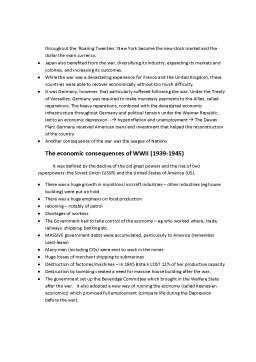Extras din curs
What Changed – Industrially and Economically:
• The invention of steam power, which replaced horses and water, was used to power factories and transport and allowed for deeper mining.
• The improvement of iron making techniques allowing for vastly higher production levels and better material.
• The textile industry was transformed by new machines – such as the Spinning Jenny - and factories, again allowing for much higher production at a lower cost.
• Better machine tools allowed for more and better machines.
• Developments in metallurgy and chemical production affected many industries.
• New and quicker transport networks were created thanks to first canals and then railways, allowing products and materials to be moved cheaper and more efficiently.
• The banking industry developed to meet the needs of entrepreneurs, providing the sorts of finance which allowed the industries to expand.
• The use of coal, and coal production, soared, replacing wood.
What Changed – Socially and Culturally:
• Rapid urbanization led to dense, cramped housing and living conditions, which spread disease, created vast new city dwelling populations, and a new sort of social order.
• New city and factory cultures affecting family and peer groups.
• Debates and laws regarding child labor, public health and working conditions.
• Anti-technology groups such as the Luddites.
Causes of the Industrial Revolution:
• The end of feudalism changes economic relationships, with feudalism used as a useful catch all term and not a claim there was classic style feudalism in Europe at any point.
• A higher population because of less disease and lower infant mortality allowed for a larger industrial workforce.
• The agricultural revolution frees people from the soil, allowing – or driving – them into cities and manufacturing, allowing more a larger industrial workforce.
• Proportionally large amounts of spare capital for investment.
• Inventions and the scientific revolution allowing for new technology.
• Colonial trade networks.
• The presence of all the required resources close together, which is why Britain was the first country to experience the full industrial revolution.
• Culture of hard work, taking risks and developing ideas.
Great Britain
• The first industrial nation
• At the end of the Napoleonic Wars Britain was the world’s leading manufacturing nation
• Superior sea power the world’s leading commercial nation
• Textile, coal, iron and engineering, the base of Britain’s early prosperity
• Produced almost twice as much coal as its leading European rivals, Belgium and Germany.
• The development of both the steam and the railways the most important new industry of the 19th century
• Reached its peak of industrial supremacy in relation to other nations in the 2 decades form 1850-1870
• Income distribution became more equal
• The proportion of population in dire poverty fell
• The per capita real income increased 2.5 times between 1850-1914
U.S.A
• Spectacular example of rapid economic growth
• Population growth resulted from the extremely high rate of natural increase
• The numbers of immigrants entering the country rose rapidly
• Income and wealth grew more rapidly than population
• Average per capita income at least doubled
• Abundant land and rich natural resources
• Rapid progress of technology and the increasing regional specialization varied climate and resources
• Its potential for a large domestic market required a vas transportation network the construction of turnpikes and canals
• The railway age began almost simultaneously in the US and GB, although for many years the US depended on British technology, equipment and capital.
France
The depression in 1882 cost France more than any other country in the 19th century. A number of factors arose to complicate and prolong it:
- Disastrous diseases
- Large losses of foreign investment from defaulting governments and bankrupt railways
- Foreign trade fell off the loss of foreign markets, domestic industry also stagnated
• Low rate of demographic growth
• less endowed with coal than the other industrialize countries exploitation more expensive
• Technology took the lead in some industries: hydropower, steel, aluminium, automobiles, aviation
• Industrial production grew more rapidly than total product
• The foundations of an important new machinery and engineering industry were laid, many of the new machines went to the domestic textile industry, woolens and cottons in particular.
• It suffered less from the depression of 1873 than other industrializing countries, and recovered more quickly.
• Railway construction
• The iron industry
“La Belle Epoque”, as the French call the years immediately preceding WW1, was a perios of material prosperity
- Had the lowest rate of urbanization
- Largest proportion of its lavor force in agriculture among major industrial nations
- Famous for the small scale of its firms 71% of firms had no wage earners
- Geographical dispersion
Preview document
Conținut arhivă zip
- The industrial revolution.docx



























